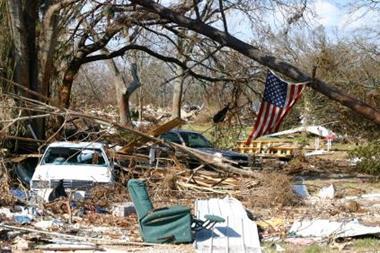How does an insurer flush out a fraudulent claim without invading the claimant’s privacy and with very low risk of being rumbled? An ex-military investigator in an invisibility suit helps. Our covert reporter signs up for intensive surveillance training
My first day in the field of espionage is tough and far from glamorous. A group of us are circling a small wooded area dressed head to toe in yeti-like camouflage suits and clutching crackling walkie-talkies. The scene is the headquarters of the Surveillance Group, where Admiral’s claims team – plus Insurance Times – is being given a taster of the murky world of surveillance.
Our objective is to find Jayne Rowe, claims negotiator from Admiral’s Cardiff office, who seems to have disappeared without a trace. Our eyes dart about as we approach the cluster of trees, peering into the shadows to try to spot signs of rustling or something amiss in the foliage. We are running out of time but the only sounds that can be heard are our feet crunching the dead leaves. It seems that despite the relatively small area and an entire team of would-be spooks, the mission is impossible.
Surveillance Group’s chief executive Tim Young yells that the game is up and at last there is movement. Rocks and branches rise up from the ground, are tossed aside, and a small figure dressed in camouflage and covered in twigs and leaves emerges from the ground. Rowe laughs, pleased at her victory in evading capture.
But today is not all about fun and games. The Surveillance Group has organised an insight day, inviting Admiral Insurance to gain an understanding of the work of its surveillance experts. For potential new recruits, predominantly from a military background, it is an opportunity to see whether this could be a future career path.
The surveillance sector has grown rapidly in recent years and is now worth £100m, according to Young. A lot of this growth is down to insurers, who are increasingly relying upon surveillance experts to help them in their battle against fraud.
After more than a decade’s experience in the insurance claims sector, Young set up the Surveillance Group 10 years ago, having spotted a niche in the market. It is here at Whittington Hall, an imposing but secluded building nestled in the Worcestershire countryside, that the organisation trains new recruits and organises surveillance expeditions.
No hiding place in claimants’ lives
Young explains that the group has a variety of public sector clients including the police and local authorities. Previous operations have included stakeouts on notorious gangland estates to film evidence against drug barons, helping child protection agencies to pin down child abusers and assisting specialist forces in tracking down human trafficking rings. The Ministry of Defence and the police use the group for surveillance training.
In addition, Surveillance Group carries out investigations for corporate clients and transport companies. But the bulk of its work, Young explains, is carried out for insurers to help them determine whether a personal injury claimant has a genuine claim. In fraudulent cases, the film footage provided by surveillance experts can be vital to securing a conviction.
The group has 36 teams of two operatives carrying out surveillance work in the UK, 28 of which are focused on personal injury claimants. “We are used by insurers and their solicitors to gain an objective view of a claimant’s disability and how this impacts on their lifestyle. We are employed to give a visual record, to give a true slice of that person’s life,” Young explains.
The group carries out operations for most of the major UK insurers and Young is proud that it has never lost an insurance client.
Suited to surveillance
The secret of this success is about to be revealed as Young leads us to the organisation’s top secret simulation centre. From the outside, it looks like a work shed but inside it holds all the tricks – and tools – of the surveillance trade.
The interior is a curious mix: sophisticated gadgets and covert cameras, a pile of rubble, a number of grubby camouflage suits hanging from the wall in the corner. Young, however, explains that these humble-looking ‘ghillie’ suits are the most important trick of all. It was one of these that helped Rowe evade her captors in the woods earlier today.
The ghillie suit is designed to resemble heavy foliage and has been traditionally used by hunters and snipers to hide from their enemies or targets. The group also uses the urban version of the suit, which is covered in stains and grime to help the operative blend into urban surroundings such as derelict building sites.
To illustrate his point, a previously undetected figure suddenly bursts from a pile of rubble dressed in an urban ghillie suit. It is this ability to disappear into the background and remain invisible to the human eye, says Young, that can help generate the best results on an expedition.
He has little patience with the popular image of surveillance teams hunched in vans outside a house ready to speed off in hot pursuit of their target. He argues that these strategies, while still used by the police, simply don’t work.
“The belief persists that if you are in a van that people are going to think you are a plumber or painter or something. That just doesn’t happen any more,” he says. “Many fraudulent claimants are as surveillance-aware as the average drug dealer on the street.”
Instead, the group tries to get operatives into a ghillie suit wherever possible on an assignment so they can film claimants at close range. “These suits allow our teams to get much closer to claimants and gain much more extensive footage without the risk of compromise by using all-too-obvious vehicles,” he explains.
An extraordinary amount of pre-planning goes into a surveillance operation to identify the best spot to film and the most opportune time to place the ghillie-suited operative into that area. Operatives also have to ensure that they do not violate current privacy laws.
“We can’t roll up and film outside their bedroom. We have to ensure that we gain footage that any member of the public could film,” he explains.” Once this is done, the operative has to remain static in this cramped space for up to 12 hours.
Trained in Afghanistan for urban jungle
Unsurprisingly, the gruelling nature of surveillance assignments means that more than 95% of the group’s operatives are former military personnel. Most non-military recruits fail to last the pace.
“We love ex-military personnel simply because they can think on their feet and are used to dealing with stressful situations and, conversely, they are used to dealing with situations where you do nothing for long periods,” Young says.
He adds that, while operatives wearing a ghillie suit have never been caught or “compromised”, all operatives have to be fully trained to deal with the possibility of violent assault.
“A lot of my guys are working on the streets in some of the worst urban environments in the UK and this includes work on insurance jobs,” he explains. “Some of them have just come out of the sandpits from Afghanistan and many say they feel just as at risk on these streets as they did on the battlefield.”
In addition to ghillie suits, the team’s identification of “trigger locations” is a key strategy in surveillance expeditions. Once they have gathered enough information about a claimant’s routine, they place un-manned cameras at carefully selected locations. “We are experts in fake trees and rocks,” Young laughs. He shows us a selection of branches, rocks and rubble that have tiny concealed cameras.
He explains that while fraudulent claimants are careful to make a great show of being injured when they are leaving their house or leaving their doctor’s surgery, perhaps by hobbling on crutches or using a wheelchair, they become less vigilant when they move away from these locations. It is then that the strategically placed cameras can help catch potential fraudsters doing activities that contradict their claims.
The teams also use mobile technologies when following a claimant on foot, with tiny inbuilt cameras in mobile phones and key fobs to ensure quality coverage at close range. “We don’t buy bog standard surveillance equipment. Because of our size, we can get companies to manufacture covert camera systems that are designed to maximise the amount of covert coverage we can get,” he says. “This means, irrespective of where a claimant goes, if they are in a public place, we will be able to get footage of them.”
We are then led to the nerve centre of the Surveillance Group’s headquarters: the editing room, where staff sift through hours of coverage to select the best footage of a claimant. Ideally, the group aims to carry out two to three days of surveillance to get a true picture of a claimant’s daily life.
The right to a fair settlement
But what of the ethical implications of spying on someone unawares? “The claimant has a right to privacy but the insurer also has a right to justice,” Young says firmly. He admits, however, that in some cases the line between privacy and justice can be blurred and ultimately it is up to the courts to decide whether the claimant’s rights outweigh the insurer’s.
There is no denying that the group’s fraud statistics are grim, however. Between 2008 and 2009, the group has carried out surveillance on 4,684 claimants, of which 18% or 834 claimants were found to be working when they said they were unable to. Of the remaining 3,850 claimants, 76% were filmed undertaking activities that directly contradicted elements of their insurance claim. “That means that only around 20% of the people we were looking at had genuine insurance claims. That is just horrific data,” Young says.
But he also stresses that Surveillance Group’s footage can prove that a claimant is telling the truth and guarantee they are getting a fair settlement. “In many of our cases, our footage will confirm brain injury and allow insurers to put in place specialist care and rehabilitation early in the process to reduce the suffering of a claimant and their family.”
Young stresses that while the surveillance sector may be booming, it remains unregulated. Consequently, he warns that insurers need to ensure they are hiring an organisation with the right credentials. In response to concerns about lax controls, the Surveillance Group has set up a set of recognised qualifications including a diploma in surveillance training in conjunction with the Ministry of Defence.
But for this particular group of operatives, the training day has come to an end. The ghillie suits and gadgets have been returned and it’s time to return to the real world. As Admiral’s group leaves, most of the ex-army staff stay on at Whittington Hall eager to glean more information about the Surveillance Group. This is no surprise. Opportunities in the surveillance sector are growing and with fraud on the rise, demand for its shadowy services is unlikely to go away. IT
Hosted by comedian and actor Tom Allen, 34 Gold, 23 Silver and 22 Bronze awards were handed out across an amazing 34 categories recognising brilliance and innovation right across the breadth of UK general insurance.














































No comments yet